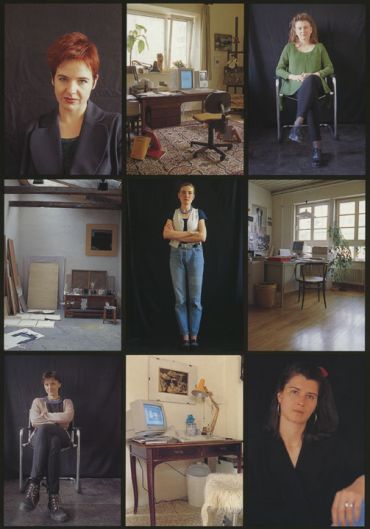1994



TRIVIAL CIRCUIT
On the entry of stories into history
The guidelines of the project were a simple matter: each one of the five artists was supposed to give his or her colleague a present as a source of inspiration for a new work of art that refers back to its source. The product of these projects was the exhibition of the results.
What has here been brought forth, is a concept of the artwork that reflects upon the convention of its production context. The autonomy of the artist as a highly productive, critical subject that is revolving around its own axis and constantly (re-)producing itself turns out to be an untenable myth and that not only in the pragmatism of the artists' everyday life. Surely this notion of the artist also had utopian and sociocritical perspectives, but today this belief seems to have receded. More than the artist who creates out of the void and his pure self, who finds himself above the work and inscribes himself within it, we come across a generation of artists who want to situate and justify their activities within the frame of social practice.
Contrary to the movements of the last years that have dealt with the criticism of institutions and were primarily engaged in the apparatus"art" and its context, and have in analysing performed in it (from Daniel Buren to Michael Asher up to Andrea Fraser), now an interest in the themes, events, stories and myths that revolve around and define our notion of social reality emerges. lf the reflexion upon institutions represented a sort of analysis of social syntax, then a form of resemantization is now unfolding, charging artistic practice with social meaning. Stories are told, stories are constructed and stories are put up for discussion: in this case stories that represent a broad range of our social reality and their perception. So the matter at hand was to reflect the patterns of identity for logos and (career) women in the same way as the fictitious representation of a psychopathic serial killer and yuppy, as well as the inspiring power of Bach cantatas or a walk of several days across the landscape. …
Vom Einzug der Geschichten in die Geschichte
Die Spielregeln des Projekts waren denkbar einfach: Jeder von den fünf Künstlern oder Künstlerinnen sollte seinen Kollegen ein Geschenk als Inspirationsquelle für eine neue, sich darauf beziehende künstlerische Arbeit machen. Das Produkt dieses Projekts war die Ausstellung der Resultate.
Was hier zur Disposition gestellt wurde, ist ein Werkbegriff, der die Konvention seines Entstehungszusammenhanges reflektiert. Die Autonomie des Künstlers, als höchst produRtives, kritisches, sich um die eigene Achse drehendes und sich permanent (re‑ )produzierendes Subjekt, entpuppt sich nicht nur in der Pragmatik des künstlerischen Alltags als unhaltbarer Mythos. Sicherlich hatte diese Vorstellung vom KOnstler auch utopische und gesellschaftskritische Perspektiven, aber heute scheint dieser Glaube in den Hintergrund getreten zu sein. Vielmehr als den aus dem Nichts oder rein aus sich selbst schöpfenden Künstler, der sich Ober das Werk findet und sich in dasselbige einschreibt, treffen wir heute auf eine Generation von Künstlern, die ihre Aktivitäten im Rahmen der gesellschaftlichen Praxis situieren und auch begründen mochte.
Im Unterschied zu den institutionskritischen Bewegungen der letzten Jahre, die sich primär auf die Apparatur ,,Kunst" und ihre Rahmenbedingungen eingelassen und diese zugleich analysierend bespielt haben (von Daniel Buren Ober Michael Asher bis zu Andrea Fraser), tritt nun ein Interesse an den Themen, Ereignissen, Geschichten und Mythen, die unsere Vorstellung von gesellschaftlicher Realität umkreisen und umschreiben, in den Vordergrund. Repräsentierte die institutionskritische Reflexion eine Art Analyse der sozialen Syntax, so entfaltet sich zunehmende eine Form der Resemantisierung, eine Aufladung der künstlerischen Praxis mit sozialer Bedeutung. Geschichten werden erzählt, Geschichten werden konstruiert, und Geschichten werden zur Diskussion gestellt:
In diesem Fall Geschichten, die ein breites Spektrum unserer gesellschaftlichen Realität und deren Wahrnehmung repräsentieren. So galt es die Identitätsmuster von Logos und für (Karriere‑)Frauen genauso zu reflektieren wie die romanhafte Darstellung eines psychopathischen Serienmörders und Yuppies, sowie die inspirierende Kraft von Bach‑Cantaten oder einem mehrtägigen Spaziergang durch die Landschaft. ...
Text: Andreas Spiegl, Translation: Florian Eichler